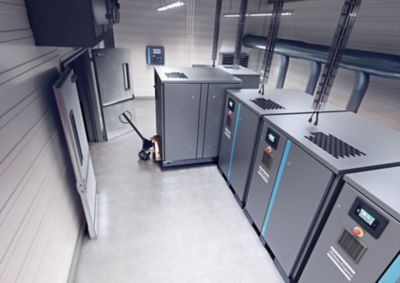Compressed Air Leak Detection
The main purpose of Atlas Copco’s air leak detection service is to build a profile of the energy wasted through air leakage within your compressed air system. Our leak detection service will find, log, quantify and cost the air leaks for you – all you’ll need to do is prioritise and schedule the remedial work required, then sit back and watch your energy costs decrease.
The best, and most widely used approach is to use ultrasonic leak detection equipment. It operates without interrupting plant operation, reaches system areas that are hard to access, and locates all air leaks.
“I have been carrying out compressed air leak detection checks for 20 years and, in my experience, 99% of sites have savings to be realised.”
Are your air compressors running harder to compensate for leaks?
If you’re not yet ready to book an on-site leak detection service, and your compressor is connected to Atlas Copco’s Smartlink, we can offer a remote compressed air leak detection service for free. This will provide you with an estimated cost of air leaks, which can be followed up by a site visit by an engineer to pinpoint and tag the source of the leak(s). Talk to us to set up a remote compressed air leak check.
What can I expect from a leak detection service?
We will arrange for a fully qualified engineer to visit your site with our state-of-the art acoustic leak detection camera. Even though the air leakage detection has to be done on a live system there will be no interruption to your production. Every leak found will be tagged and logged by our engineer. Afterwards you will receive an itemised, written report which shows the results in a clearly understood and actionable format.
Atlas Copco always carries out risk assessments and method statements prior to a site visit and our engineers are equipped with the appropriate PPE.
Our step by step leak detection process
Step 1: Assess the air network
Walk the line to understand the distribution of the compressed air pipework network and usage.Step 2: Audit the air network Take an ultrasonic leak detection check. It not only recognises the compressed air leaks, it carries out on-board analysis to pinpoint the exact source of leak and size of leak in litres/minute. Step 3: Identify and tag the leaks Each individual weatherproof tag will carry an identification number stating the date and severity of the leak in l/min. Step 4: Report the results The report will list the leaks and show: • Site location • Photographs of leak• Tag ID • Severity of leak (l/min) • Cost of leak £’s • Position of leak • Cost to repair Step 5: Prevent future leaks Take a proactive approach to monitoring and controlling leaks on an ongoing basis.
Guaranteed results: The leak detection service is free of charge if we don’t uncover enough savings to be made. It’s an offer you can’t refuse!
What will happen after the leak detection service?
Once you have had time to read and digest the findings in the report, we will send a quotation to repair the air leaks. Atlas Copco can also, if required, develop a monitoring and control programme to suit your individual needs. Our aim is to offer a solution that will reduce the cost of generating compressed air and therefore lead to a direct increase in your company’s profits.
How does Atlas Copco’s leak detection kit compare to others?
The cost of air leaks
All compressed air systems have leaks due to causes like corrosion, poor pipe connections, and bad seals. The British Compressed Air Society states that the average leakage rate is 25%, with some plants losing up to 80%. This is like losing a quarter of your car's fuel through a leaky line.
Leaks waste money. The Carbon Trust estimates that a 3mm hole in a compressed air pipe can cost up to £1,000 per year in wasted electricity. Fixing leaks lowers energy costs and may reduce compressor running hours and maintenance costs. However, it's almost impossible to repair all leaks, and new ones will occur over time.
Best practice is to keep leakage below 10% of total compressed air production. Check your system for leaks at least once a year to control energy wastage.
Some users are simply not aware of the extent of any onsite leakage, or the associated cost; others are concerned that any audit will be disruptive and time-consuming. Yet, when done correctly, auditing can be efficient, fast and hassle-free, while highlighting opportunities for energy-saving and process improvements.
Examples of companies who have reduced their energy bill after detecting and fixing their compressed air leaks
- A global manufacturer of connectors and sensors saved £48,000
- A producer of health, hygiene and home products saved £40,000
- A leading multinational automotive manufacturer saved £22,000
- One of the UK’s largest food companies saved £45,000

Terms and Conditions of the free Leak Detection Service
The leak detection service must be booked directly with Atlas Copco Compressors. We will not invoice you for the leak detection service if we do not find enough energy savings to cover the cost of the check, if you repaired the leaks.


